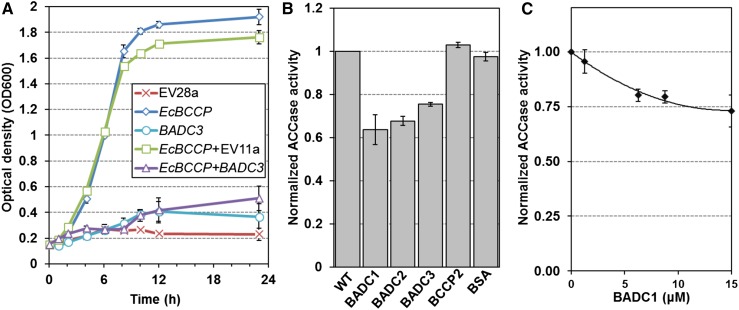Figure 7.
BADCs Reduce ACCase Activity in E. coli and Arabidopsis.
(A) Growth curves showing the optical density of L8 E. coli cells over time. Cultures were grown in liquid culture at 37°C. Transformed cells contained the following vectors: empty pET28a (EV28a), pET28a containing the E. coli BCCP gene (EcBCCP), empty pET11a (EV11a), and/or pET11a containing the Arabidopsis BADC3 gene (BADC3). BADC3 expression alone showed no statistical difference from EV control except at T = 10 h, while coexpression of BADC3 with EcBCCP showed an approximate 72% reduction in growth compared with EcBCCP+EV11a at T = 24 h. Results shown are representative of three separate experiments. Error bars represent sd.
(B) Protein extracted from 10-d-old Arabidopsis siliques was assayed for ACCase activity by incorporation of radiolabeled sodium bicarbonate into acid-stable products. Assays were performed in the absence (WT) or presence of 10 μM recombinant BADC1, BADC2, BADC3, BCCP2, or BSA. Specific activities were calculated for each assay and then normalized to wild-type control. Specific activities of controls ranged from 1.5 to 2.5 nmol/mg/min. Four biological replicates were performed for each trial. Each replicate consisted of three light-adapted whole siliques. Error bars denote se.
(C) ACCase activity was monitored in 20-d-old leaf extracts with increasing concentrations of recombinant BADC1; 0 μM controls were normalized to 1. Specific activity values for controls ranged from 0.84 to 2.00 nmol/min/mg. Shown is average of four biological replicates. Each biological replicate contained four light-adapted leaves. Error bars denote se.

